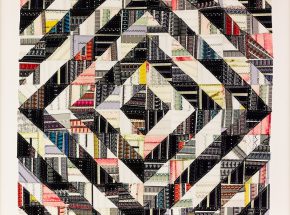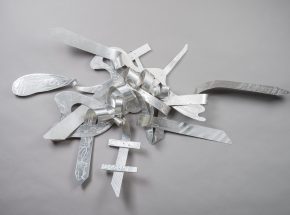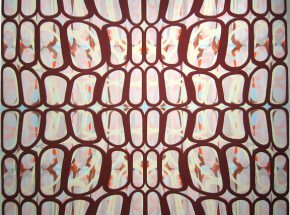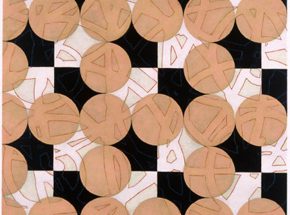

My paintings begin with a grid and a ruled, measured drawing. The geometric armatures are developed and defined by a layering of painterly processes where countervailing elements leave their imprints on each other, interpenetrating and interacting with constructive interference. The resulting space is not based on the illusion of three dimensions, but is one that continuously shifts and reconfigures. Forms circulate above, on, below, and through the layered surface in which they are grounded. I find the opposition of the physically constructed painting and the optically unstable space to be endlessly fruitful. One of painting’s great strengths is the simultaneous presentation of the tactile and the optical. The viewer must resolve these different perceptual experiences, accepting the interchange between the two. At some point, each painting takes on a life of its own and is carried towards an unpredictable complexity that is not imposed, but is discovered in the painting process.
As in earlier work, my most recent paintings focus on the interaction of grids, geometric structures, and gestural, free-drawn elements. In the newest work, however, much of the underpinning activity has been buried in layers of paint, leaving a field of forms that mark the intersections of these underlying structures. The viewer is left with a sense of contingent order when faced with an array of elements that resist resolution into a single, stable reading. Linkages and configurations form, but these slip constantly into new, unpredictable connections. This makes any hierarchy that emerges in the paintings feel tenuous, and dependent upon the viewer’s attention.
For many years, my work has been informed by the history and philosophical implications of the physical and cognitive sciences, and mathematics. I find the paradoxical and counterintuitive concepts generated by these fields most intriguing. The relationships between models, systems, organizational structures, and natural forms or processes fascinate me. Research into plane geometry, systems, pattern, networks, repetition, figure-ground relationships, tesselation, tiling, fractals, cellular automata, architectural structures, diagrams, maps, charts, instructions, rules, puzzles, games, and especially music, has found its way into my work. The paintings are not, however, illustrations of principles or demonstrations of scientific or mathematical information. My intention is more generalized and philosophical, even poetic. I am most interested in how these images and ideas become metaphorical and allusive through their embodiment in the abstract forms of the paintings, where image and process are intertwined.
Website
http://www.wc-richardson.com



